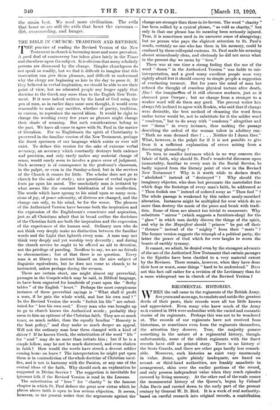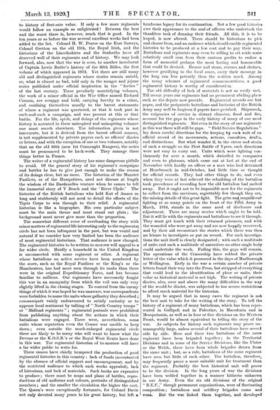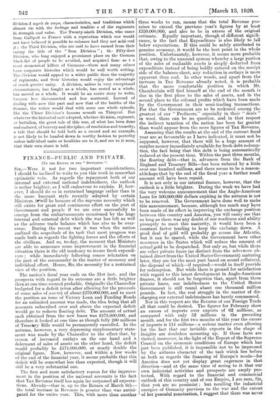REGIMENTAL HISTORIES.
WHEN the call came to the regiments of the British Army, five years and more ago, to emulate and outdo the greatest deeds of their pasts, their records were all too little known and appreciated. Even many who knew much of the Army as it existed in 1914 were unfamiliar with the varied and romantic stories of its regiments. Perhaps this was not to be wondered at. The records of our regiments have not received from historians, or sometimes even from the regiments themselves, the attention they deserve. True, the majority possess something in the nature of a regimental history, though, unfortunately, some of the oldest regiments with the finest records have still no printed story. There is no history of the Soots Guards, and there are other gaps hardly less remark- able. Moreover, such histories as exist vary enormously in value. Some, quite plainly inadequate, are based on second- or third-hand authorities, are frankly annalistic in arrangement, skim over the earlier portions of the record, and only possess independent value when they reach episodes covered by living memory. At the other end of the scale comes the monumental history of the Queen's, begun by Colonel John Davis and carried down to the early part of the present century by General W. D. Bird. It is a work of real authority, based on careful research into original records, a contribution to history of first-rate value. If only a few more regiments would follow an example so enlightened ! Between the best and the worst there is, however, much that is good. In the ten years or so before the war several excellent works had been added to the list. Colonel H. W. Pearse on the East Surreys, Colonel Gretton on the old 18th, the Royal Irish, and the historians of the Lincolnshires and the Seaforths have all deserved well of their regiments and of history. We may look forward, also, now that the war is over, to another instalment of Captain Lewis Butler's history of the 60th Rifles, the first volume of which appeared in 1913. Yet there are still many old and distinguished regiments whose stories remain untold, or, what is almost as bad, told only in the meagre and jejune series published under official inspiration in the " forties " of the last century. These peculiarly unsatisfying volumes, the work of a minor official in the War Office named Richard Cannon, are scrappy and bald, carrying brevity to a crime, and confining themselves usually to the barest statements of where a regiment was quartered, or that it took part in such-and-such a campaign, and was present at this or that battle. For the life, spirit, and doings of the regiments whose history is narrated in these uninspired and uninspiring volumes one must search elsewhere. The information given is not inaccurate, but it is derived from the barest official sources, is uot supplemented by private papers such as officers' diaries or letters, and with the exception of one or two volumes, notably that on the old 88th (now 1st Connaught Rangers), the series must be pronounced to be hack-work. They manage these things better in France.
The writer of a regimental history has some dangerous pitfalls to avoid. Of the general story of his regiment's campaigns and battles he has to give just enough to make the reason of its doings clear, but no more. The historian of the Munster Fusiliers, or of the Hampshires, need not discuss at length the wisdom of the Dardanelles venture when he comes to tell the immortal story of V Beach and the ' River Clyde.' The histories of the British battalions who held Kut el Amara so long and stubbornly will not need to detail the efforts of the Tigris Corps to win through to their relief. A regimental historian is like a biographer. His own particular subject must be the main theme and must stand out plain ; the background must never give more than the proportion.
The somewhat different error of overloading the story with minor matters of regimental life interesting only to the regimental circle has not been infrequent in the past, but was venial and natural if we consider how very limited has been the audience of most regimental historians. That audience is now changed. The regimental histories to be written to-morrow will appeal to a far wider circle. Hardly a household in the United Kingdom is unconnected with some regiment or other. A regiment whose battalions on active service have been numbered by the score, such as the Royal Fusiliers or the King's or the Manchesters, has had more men through its ranks than there were in the original Expeditionary Force, and has become familiar to millions. Our regiments have necessarily fought this war in an anonymity from which the veil was only very slightly lifted in the closing stages. To conceal from the enemy things of which it was hoped he was unaware, war correspondents were forbidden to name the units whose gallantry they described ; communiques vainly endeavoured to satisfy curiosity or to appease local sentiment by talking of " North Country troops " or " Midland regiments " ; regimental journals were prohibited from publishing anything about the actions in which their battalions were engaged. There were, nevertheless, some units whose reputation even the Censor was unable to keep down ; even outside the much-enlarged regimental circle there are likely to be many who will want to know what the Devons or the K.O.S.B.'s or the Royal West Kents have done in this war. The regimental historian of to-morrow will have a far wider public to write for.
Three causes have chiefly hampered the production of good regimental histories in this country : lack of funds (accentuated by the absence of official support and encouragement, and by the restricted audience to which such works appealed), lack of historians, and lack of materials. Such books are expensive to produce ; there must be maps and plans of battles, repro- ductions of old uniforms and colours, portraits of distinguished members ; and the smaller the circulation the higher the cost. The Queen's were exceptionally fortunate, for Colonel Davis not only devoted many years to his great history, but left a handsome legacy for its continuation. Not a few good histories owe their appearance to the zeal of officers who undertook the thankless task of dunning their friends. All this, it is to be hoped, is now altered. There should be historians to pick and choose from, and an audience which should enable regimental histories to be produced at a low cost and to pay their way. Battalions and regiments may even be willing to set aside some relatively small sum from their canteen profits to endow a form of memorial perhaps the most lasting and honourable that could be devised. Bronze and stone, statues and shrines, however gratifying to the local sense, carry their message in the long run less potently than the written word. Among the many schemes of regimental commemorations, a good regimental history is worthy of consideration.
The old difficulty of lack of materials is not so easily met. Till recent years our regiments had no permanent abiding-place such as the depots now provide. Regimental records are but paper, and the peripatetic battalions and batteries of the British Army may well be forgiven if papers have perished. Shipwreck, the exigencies of service in distant climates, flood and fire, account for the gaps in the early history of many of our most distinguished regiments. But even in the story of our regiments in this war there will still be gaps. " Field Service Regulations " lay down careful directions for the keeping by each unit of an official record of its movements, actions, Casualties, drafts, and distinctions. But what wonder if, in the stress and strain of such a struggle as the First Battle of Ypres, such directions were not easy to carry out. Units which were fighting con- tinuously for over a month, which dwindled to companies and even to platoons, which came out at last at the end of November with hardly an officer or a man who had detrained at Hazebrouck in mid-October, had little time or thought for official records. They had other things to do, and even when they were at last relieved the rebuilding of the battalion took precedence of recording how the old battalion had .melted away. But it ought not to be impossible now for the regiments to collect from the survivors, regrettably few though they are, the missing details of this great fight. The grim an4 magnificent fighting at so many points on the front of the Fifth Army in March, 1918, stands in the same need of disclosure and adjustment. There are many stories which ought to be told. But it will lie with the regiments and battalions to see it through. They must get touch with their returned prisoners, and with the wounded who were got away and are now happily recovered, and by their aid reconstruct the stories which there was then no leisure to investigate or put on record. For such investiga- tions the unit itself is clearly designated ; with such a multitude of units and such a multitude of narratives no other single body could undertake the work. Failing this, the gaps will remain. The operations of the Censorship have robbed the private letter of the value which it possessed in the days of Marlborough or Wellington. Early in the war a certain number of private letters found their way into the Press, but stripped of everything that could lead to the identification of place or units, their value as historical material is not high. The writing of private diaries, also, over and above the many difficulties in the way of the would-be diarist, was subjected to too severe restrictions to afford much material for the historian.
It may be argued that in many cases the regiment is not the best unit to take for the writing of the story. To tell the history of a regiment of many battalions, which has been repre- sented in Gallipoli and in Palestine, in Macedonia and in Mesopotamia, as well as in four or five divisions on the Western Front, would be almost equivalent to telling the story of the war. As subjects for history such regiments may prove un- manageably large, unless several of their battalions have served side by side. Here and there two battalions of the same regiment have been brigaded together ; in the Territorial Divisions and in some of the Service Divisions, like the Ulster or the Welsh, there have been whole brigades drawn from the same unit ; but, as a rule, battalions of the same regiment have seen but little of each other. The battalion, therefore, may frequently prove a more suitable unit for treatment than the regiment. Probably the best historical unit will prove to be the division. In the long years of war the divisions have been welded together in a manner hitherto unknown in our Army. Even the six old divisions of the original " B.E.F.," though permanent organizations, were of fluctuating composition ; battalions and artillery brigades came and went. But the war linked them together, and developed
divisional esprit de corps, characteristics, and traditions which almost vie with the feelings and traditio a of the regiments in strength and value. The Twenty-ninth Division, who came from Gallipoli to France with a reputation which one would not have believed it possible to enhance had they not achieved it ; the Third Division, who are said to have earned from their enemy the title of the " Iron Division " ; the Fifty-first Division, who long enjoyed a prominent place on the German black-list of people to be avoided, and acquired fame as t e most economical killers of Germans—these and many others have corporate histories which would be well worth writing. The division would appeal to a wider public than the majority of regiments, and their histories would enjoy the advantage of much greater unity. A division, unless in very exceptional circumstances, has fought as a whole, has rested as a whole, has moved as a whole. It would he an easier story to write, because less disconnected and less scattered. Instead of dealing with now this part and now that of the battles of the Somme, the writer would deal with some one whole episode, like the Ulster Division's famous assault on Thiepval. But whatever the historical unit adopted, whether division, regiment, or battalion, the great tale of this war, of what has been done and endured, of bravery and discipline, of resolution and tenacity, a tale that should be told both as a record and an example, is not likely to be handed down in worthy fashion to posterity unless individual units or localities see to it, and see to it soon, that their own share is told.












































 Previous page
Previous page